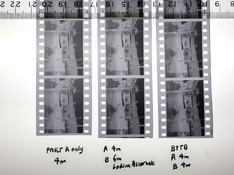Alan Johnson
Subscriber
- Joined
- Nov 16, 2004
- Messages
- 3,294
I received an interesting message from Raghu K in India to the effect that he had found sodium ascorbate (not ascorbic acid) could be used as a B bath in Barry Thornton's 2 bath developer (BTTB) and I tried it out to see if the idea could be verified.
Some initial results suggested that 5g/L sodium ascorbate (about 2 level teaspoons) would be a good level for a test.
My test with Barry Thornton's two bath part A + various part B using FP4 type 517 cine film* EI=100, 22+/- 0.5C:
BTTB part A only ,5 inversions at start then 2 inversions on each minute, time 4m.
BTTB part A 4m, part B 5g/L sodium ascorbate 6m agitate 2 inversions at start and 2 inversions at 3 m, total time 6m.
BTTB part A 4m, part B 12g/L metaborate 4m agitate 2 inversions at start and 2 inversions at 2 m., total time 4m.
Sodium ascorbate 5g is closely equal to 2 level teaspoons.
*FP4 type 517 cine film is from a large quantity of outdated film sold cheaply by Analogue Cameras in UK, its EI is given as 100.
It can be seen from the attachment that there is significant development in part A alone, the density increases in both part B sodium metaborate and in part B sodium ascorbate.
Raghu's report appears to be true.
From the scans, it does appear that sodium ascorbate gives slightly higher contrast and possibly slightly finer grain. It's hard to see this on the <2mb scans attached here. Possibly most of the grain comes from the part A development.
What use might this be? One application seems to be that it is easier to buy sodium ascorbate than it is to buy the metaborate usually specified for BTTB as sodium ascorbate is a food supplement and 2 level teaspoons of it per liter should do a similar job to 12g/L metaborate. That is a preliminary result and comments welcome.
Some initial results suggested that 5g/L sodium ascorbate (about 2 level teaspoons) would be a good level for a test.
My test with Barry Thornton's two bath part A + various part B using FP4 type 517 cine film* EI=100, 22+/- 0.5C:
BTTB part A only ,5 inversions at start then 2 inversions on each minute, time 4m.
BTTB part A 4m, part B 5g/L sodium ascorbate 6m agitate 2 inversions at start and 2 inversions at 3 m, total time 6m.
BTTB part A 4m, part B 12g/L metaborate 4m agitate 2 inversions at start and 2 inversions at 2 m., total time 4m.
Sodium ascorbate 5g is closely equal to 2 level teaspoons.
*FP4 type 517 cine film is from a large quantity of outdated film sold cheaply by Analogue Cameras in UK, its EI is given as 100.
It can be seen from the attachment that there is significant development in part A alone, the density increases in both part B sodium metaborate and in part B sodium ascorbate.
Raghu's report appears to be true.
From the scans, it does appear that sodium ascorbate gives slightly higher contrast and possibly slightly finer grain. It's hard to see this on the <2mb scans attached here. Possibly most of the grain comes from the part A development.
What use might this be? One application seems to be that it is easier to buy sodium ascorbate than it is to buy the metaborate usually specified for BTTB as sodium ascorbate is a food supplement and 2 level teaspoons of it per liter should do a similar job to 12g/L metaborate. That is a preliminary result and comments welcome.














